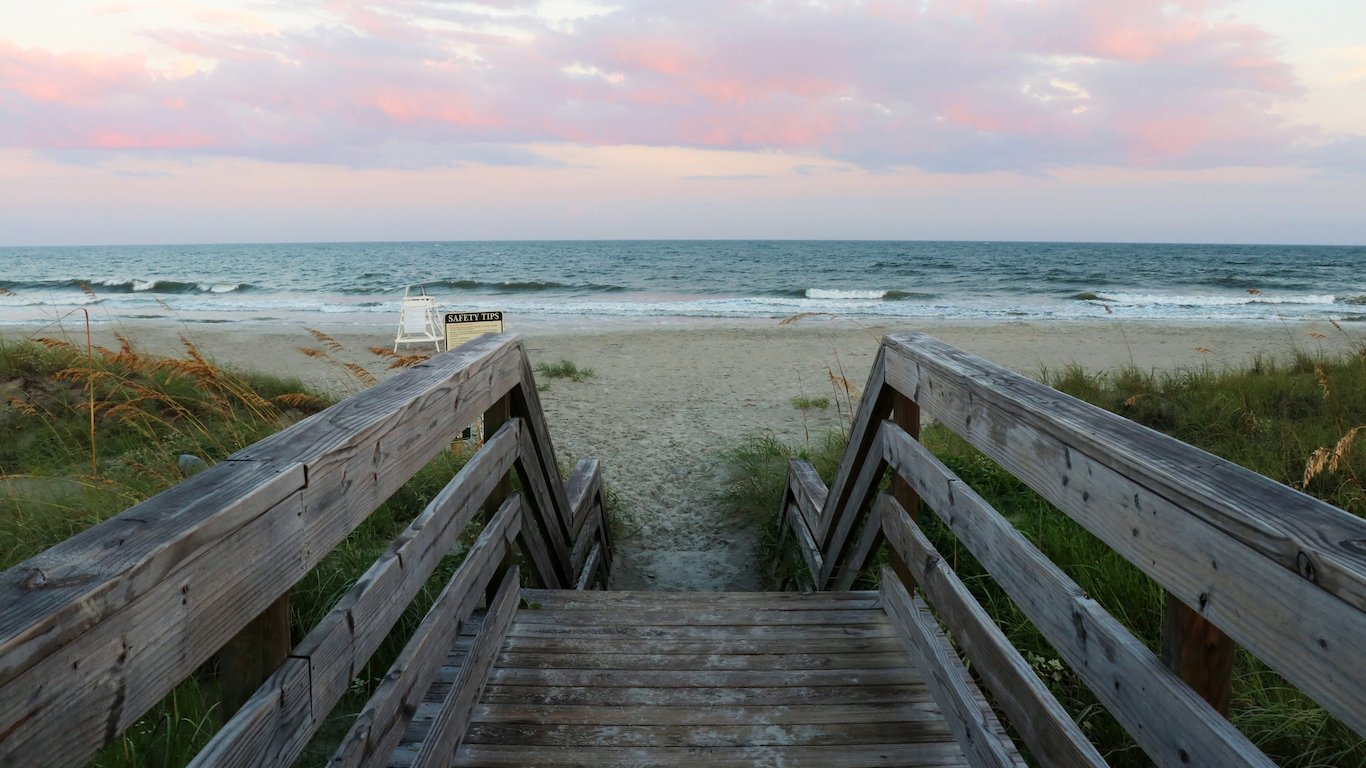

There are nearly 1.5 million vacant homes in the United States, or 1.5% of all homes, according to a new report from real estate data company ATTOM Data Solutions. While this represents a slight improvement from the previous year’s vacancy rate of 1.6%, certain pockets of the country have so many empty homes they can feel like ghost towns.
There are neighborhoods with exceptionally high vacancy rates across the United States — from pricey coastal communities like Belleair Beach in Florida, to impoverished communities in Rust Belt cities like Youngstown, Ohio.
While areas like these share near nation-leading vacancy rates, the similarities stop there.
In inner-city neighborhoods in parts of the Midwest and mid-Atlantic, depressed housing markets and widespread poverty have contributed to long-term population decline. In these areas, many homes are effectively abandoned.
Meanwhile, in wealthier beach communities, many homes are only used seasonally by the owners or as rental properties for vacationers, and vacancy rates in these areas fluctuate throughout the year.
24/7 Wall St. reviewed the share of single family homes that were unoccupied as of the end of the third quarter in 2018 to identify the 30 ZIP codes with the highest vacancy rates — America’s ghost towns. Vacancy rates in these areas, which were calculated by ATTOM Data Solutions at the ZIP code level using tax assessor data, range from 16.2% to 31.4%.
Click here to see the 30 American ghost towns.
Click here to read our detailed findings and methodology.
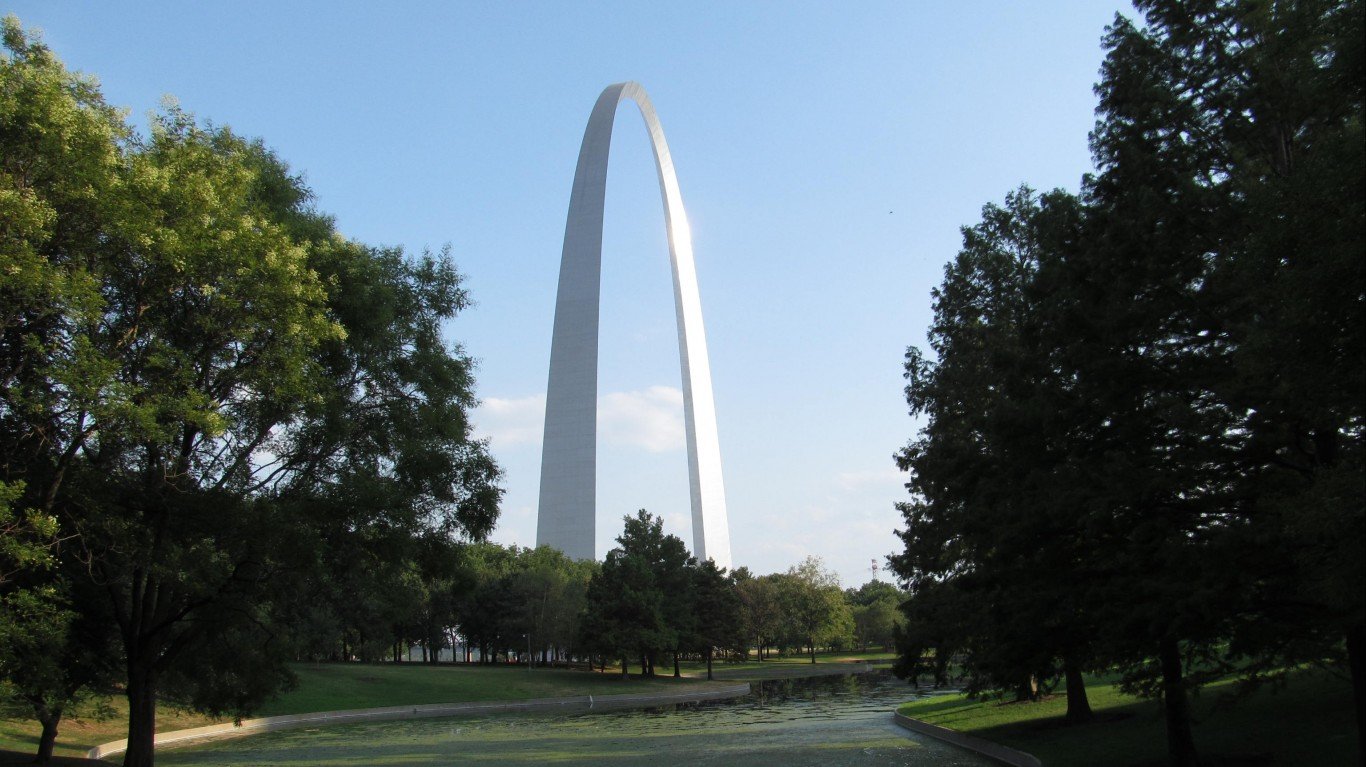
30. ZIP 63133 (St. Louis, Missouri)
> Vacant homes: 437 (16.2%)
> 5 yr. population change: -13.0%
> Population: 7,507
> Median home value: $55,000
Of the nearly 2,700 single family homes in St. Louis’s 63133 postal code, 437 are unoccupied. The high vacancy rate is partially attributable to the area’s declining population. In the last five years, the ZIP code’s population dipped by 13.0%. Over the same period, the population of the broader St. Louis metro area remained effectively unchanged.
As is the case with many neighborhoods on this list, the 63133 ZIP code, which is just north of Washington University and bisected by route 180, is marked by economic strife. The area’s 39.5% poverty rate is more than double the national poverty rate of 15.1%. Additionally, likely due in part to widespread vacancy, the typical area home is worth just $55,000. To compare, the typical American home is worth nearly $185,000.
[in-text-ad]
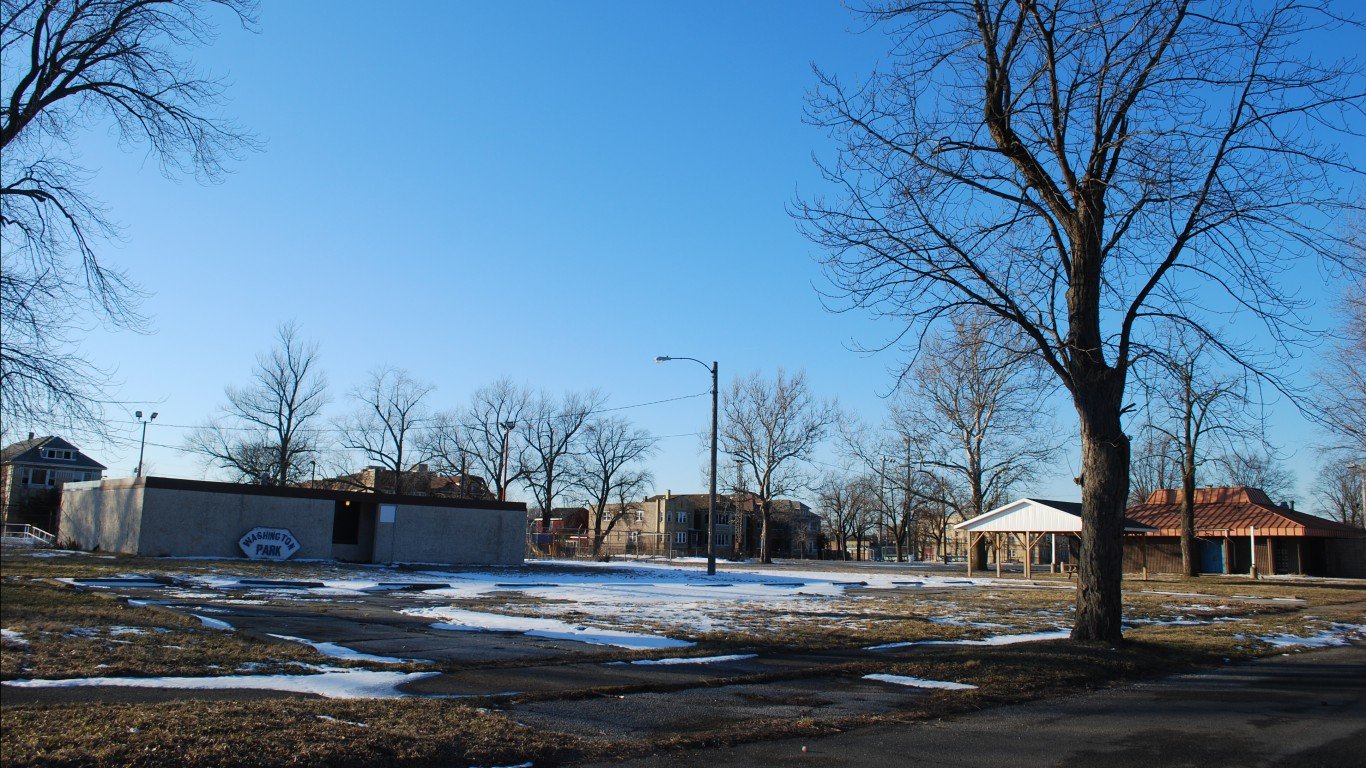
29. ZIP 46404 (Gary, Indiana)
> Vacant homes: 1,005 (16.3%)
> 5 yr. population change: -1.2%
> Population: 17,332
> Median home value: $68,900
Though it is a relatively small city, home to less than 80,000 residents, Gary, Indiana, has more neighborhoods with near nation-leading vacancy rates than any other U.S. city. Over 1,000 single family homes in the 46404 ZIP code in western Gary are vacant.
Like many other ZIP codes on this list, property values are low in is this section of Gary. The typical area home is worth just $68,900, less than half the value of the typical U.S. home of $184,700. Some are taking advantage of the depreciated home values. More than two-thirds of vacant homes in the area are investment properties. Though they are currently without renters, these homes could be sold at a profit should demand for housing makes a come back in Gary.
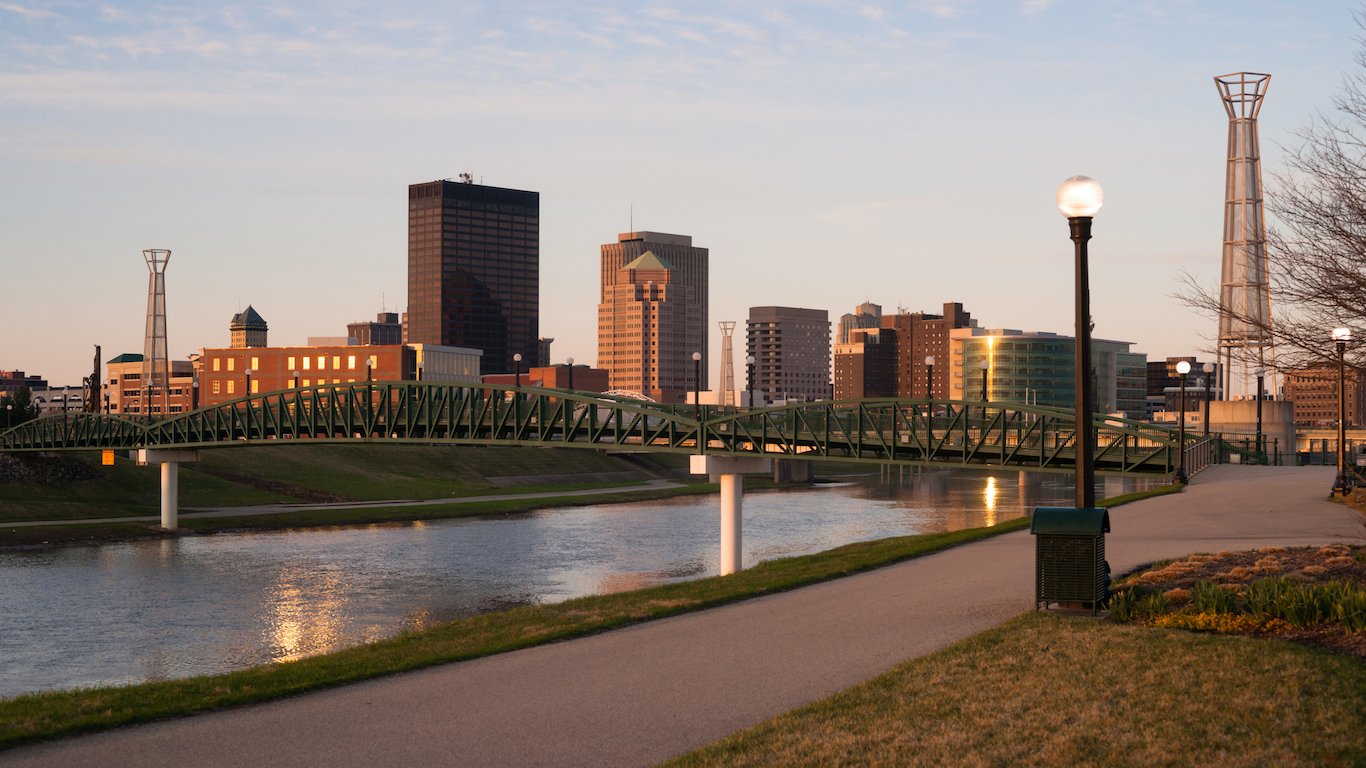
28. ZIP 45402 (Dayton, Ohio)
> Vacant homes: 574 (16.3%)
> 5 yr. population change: -8.8%
> Population: 9,972
> Median home value: $60,200
The 45402 ZIP code in Dayton, Ohio, is one of the poorest neighborhoods in the country. The typical area household earns just $20,718 a year, and nearly 47% of the neighborhood’s 9,972 residents live in poverty. Economic blight may be driving people out of the neighborhood. In the last five years, the 45402 ZIP code’s population fell by 8.8%, and currently, 16.3% of area homes are unoccupied.
The 45402 ZIP is centrally located in the city and is bisected by the Great Miami River. The area’s declining population and abandoned homes are a highly concentrated example of what is happening in the broader Dayton area. In the last five year, the Dayton metro area population shrank by 5.0%, and 3.0% of metro area households are unoccupied, more than in all but seven other metro areas nationwide.

27. ZIP 96013 (Burney, California)
> Vacant homes: 220 (16.5%)
> 5 yr. population change: 25.6%
> Population: 4,538
> Median home value: $135,100
The 96013 ZIP code encompases the town of Burney, California, and extends over a large swath of land north of the town. There are an estimated 220 vacant homes in the ZIP code, or 16.5% of all single family homes and condos in the area. Unlike most towns and neighborhoods on this list, the population of Burney and parts of the surrounding area are growing. In the last five years, the number of residents in the 96013 ZIP code has grown by 25.6%, far outpacing the 3.9% national population growth over the same period.
While in many parts of the country high vacancy rates are largely attributable to people abandoning their homes, this is not the case in Burney. Of the 220 vacant homes, 186, or 85%, are investment properties. Nationwide, 75% of vacant homes are investment properties.
[in-text-ad-2]
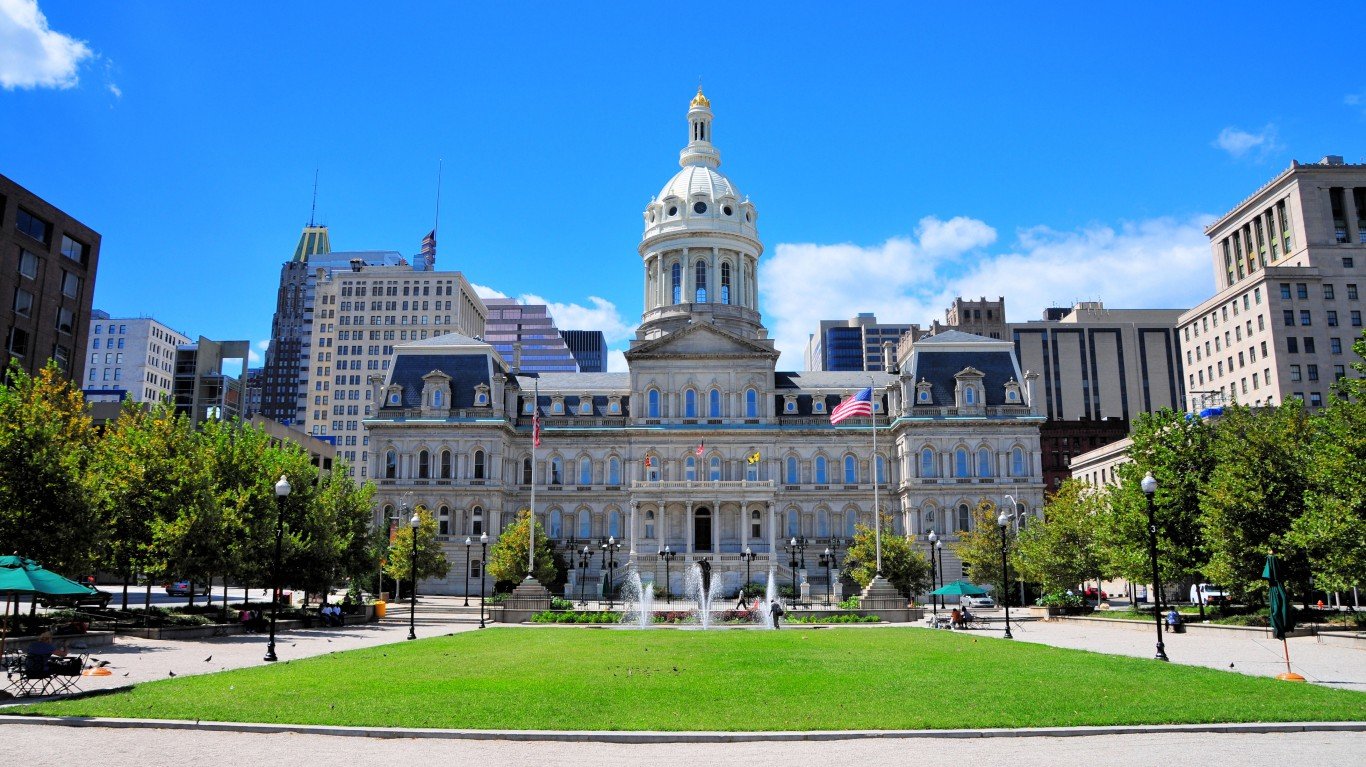
26. ZIP 21217 (Baltimore, Maryland)
> Vacant homes: 2,145 (16.5%)
> 5 yr. population change: -1.6%
> Population: 38,596
> Median home value: $117,300
Situated on the south side of Druid Hill Park in northwest Baltimore, the 21217 ZIP code covers the city’s Reservoir Hill, Penn North, Druid Heights, Bolton Hill, and Upton neighborhoods. Far poorer than much of the surrounding metro area, more than one in three ZIP code residents live below the poverty line, compared to about one in 10 Baltimore metro area residents. In the last five years, the area’s population fell by 1.6%, evan as the broader Baltimore metro area population grew by 3.1%.
Poor economic conditions may be driving people out of the area and contributing to a near nation-leading home vacancy rate. More than 2,100 homes, or 16.5% of all single family homes, in the 21217 ZIP are unoccupied, well above the 2.5% share across the broader Baltimore metro area.
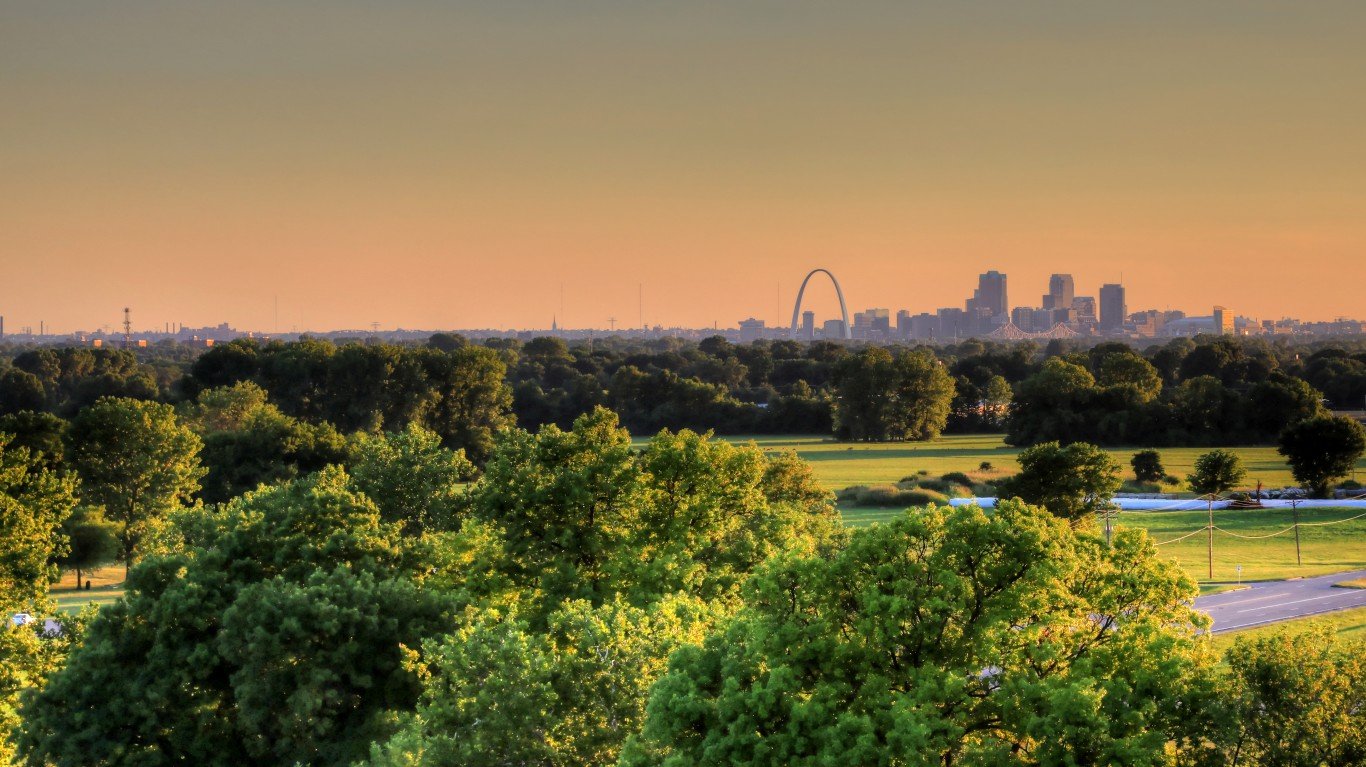
25. ZIP 63113 (St. Louis, Missouri)
> Vacant homes: 528 (16.6%)
> 5 yr. population change: -11.7%
> Population: 11,270
> Median home value: $60,400
The 63113 ZIP code is located just north of the Central West End neighborhood in St. Louis. Some 16.6% of single family homes in this section of the city are unoccupied, one of the largest shares anywhere in the United States. The high vacancy rate actually represents an improvement from a year ago. The number of unoccupied homes in the 63113 ZIP code fell from 820 in 2017 to 528 this year.
Like many parts of the country with high vacancy rates, the 63113 ZIP code is a poor part of a dangerous city. More than one in every five area households earn less than $10,000 a year, and 39% of area residents live below the poverty line. Across the broader St. Louis metro area, there were 12.6 murders for every 100,000 residents in 2017 — more than double the 5.3 per 100,000 U.S. murder rate.
[in-text-ad]
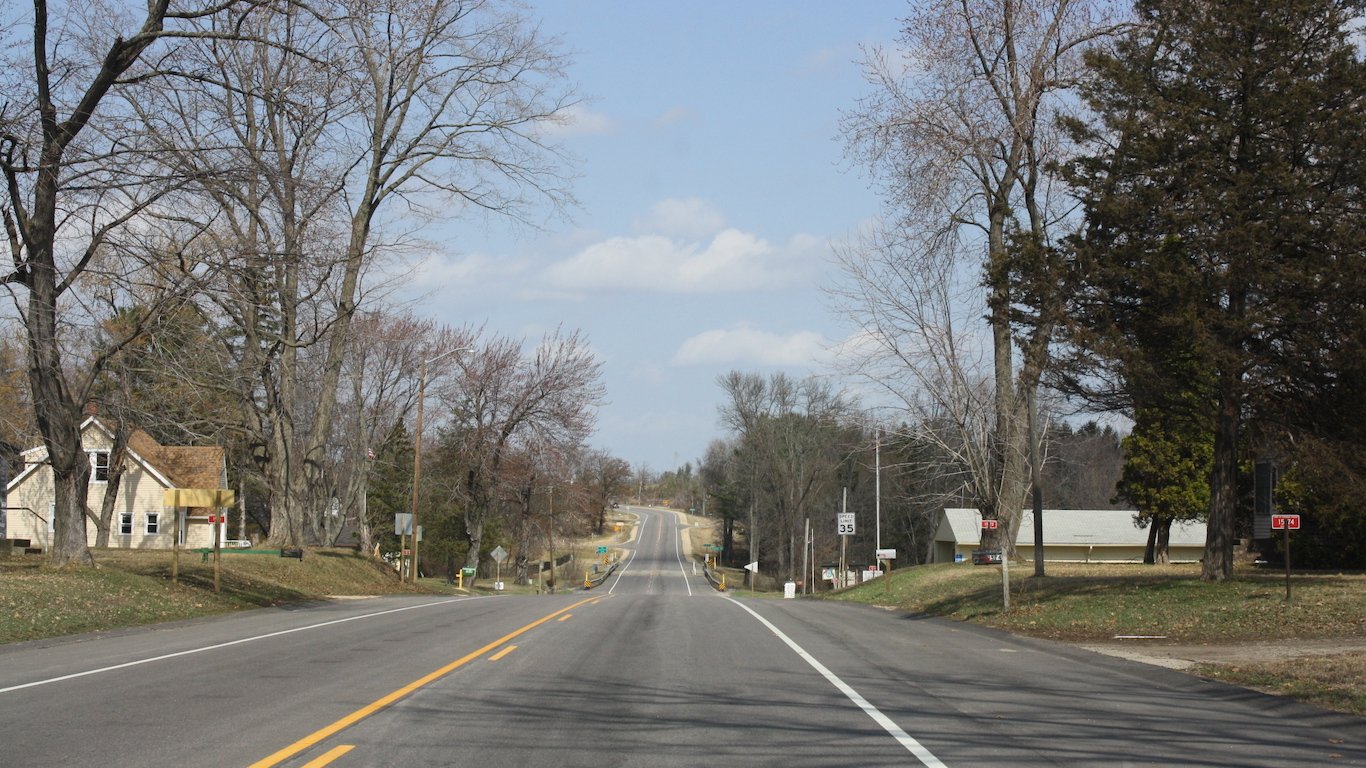
24. ZIP 54613 (Arkdale, Wisconsin)
> Vacant homes: 404 (16.7%)
> 5 yr. population change: -14.7%
> Population: 1,774
> Median home value: $117,700
Most areas with high vacancy rates lie within large metro areas, but Wisconsin’s 54613 ZIP code is an exception. The area contains the small town of Arkdale on its east side and is bordered by Petenwell Lake and the Wisconsin River on its west side. Many of the 404 vacant homes in the area are likely vacation properties. The area is a popular place for vacationers for its large swaths of public land open for snowmobiling and hunting. There are also golf courses in the area and fishing in nearby lakes and streams.

23. ZIP 54745 (Holcombe, Wisconsin)
> Vacant homes: 287 (16.7%)
> 5 yr. population change: -8.5%
> Population: 1,979
> Median home value: $184,000
In the last five years, the population of the 54745 ZIP code in northern Wisconsin has shrank by 8.5%. The population decline likely partially explains the high vacancy rates and in the last year, as the number of vacant single family homes in the area climbed slightly from 281 to 287. The ZIP code contains the town of Lake Holcombe as well as the Holcombe Flowage reservoir.
Unlike many ZIP codes on this list, the high vacancy rate around Holcombe is likely attributable to periodically unoccupied vacation homes. The area boasts over 3,400 acres of public forest for hunting, hiking, and horseback riding in addition to 120 miles of shoreline for fishing and 400 miles of groomed snowmobile trails in the winter. There are also multiple golf courses in the area.

22. ZIP 48205 (Detroit, Michigan)
> Vacant homes: 2,223 (17.0%)
> 5 yr. population change: -18.5%
> Population: 35,925
> Median home value: $29,200
The 48205 ZIP code is located in northern Detroit and is one of two areas in Motor City with near nation-leading home vacancy rates. Many inner-city areas with high concentrations of unoccupied homes are poor and have depressed real estate markets. In the 48205 ZIP code, more than one in every three residents live below the poverty line, and the typical home is worth just $29,200, less than one-sixth the $184,700 median home value nationwide.
Vacancy rates are improving in this economically distressed area. The 2,223 unoccupied are homes this year represents a 24.2% improvement from the 2,932 vacant area homes in 2017.
[in-text-ad-2]
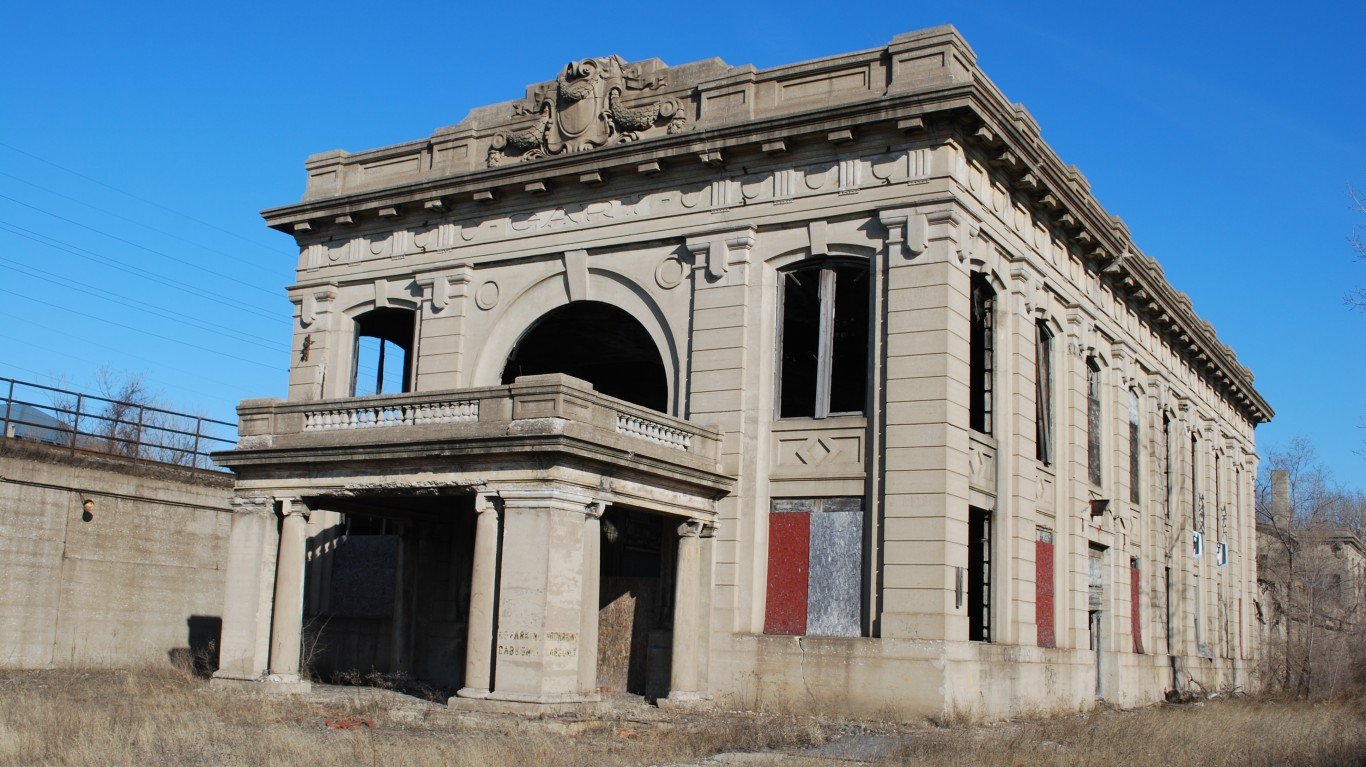
21. ZIP 46406 (Gary, Indiana)
> Vacant homes: 595 (17.3%)
> 5 yr. population change: -6.9%
> Population: 9,402
> Median home value: $53,900
The 46406 ZIP code is one of five in Gary, Indiana, to report some of the highest home vacancy rates in the United States. Comprising the westernmost section of the Rust Belt city, the 46406 area code has a 17.3% home vacancy rate. Like many inner-city ZIP codes with high vacancy rates, west Gary is low income and relatively dangerous. More than one in three area residents live in poverty, and the broader metro area’s murder rate of 9.4 homicides per 100,000 residents is nearly double the U.S. murder rate of 5.3 per 100,000.
Gary Mayor Karen Freeman-Wilson is spearheading an initiative to bring the city back and reduce the number of vacant properties. In the last year alone, there have been improvements. The number of vacant single family homes declined 7.6% from 644 in 2017 to 595 in 2018.

20. ZIP 21223 (Baltimore, Maryland)
> Vacant homes: 2,156 (17.4%)
> 5 yr. population change: -2.7%
> Population: 25,127
> Median home value: $69,500
There were an estimated 16,800 vacant homes in Baltimore in the wake of the financial crisis in 2010. In the years since, the city has invested millions to demolish abandoned blocks — but still, an estimated 16,300 homes remain unoccupied. Much of the progress from the demolition has been offset as people have been leaving the city in recent years, reducing demand for housing. As recently as 2014, Baltimore was home to nearly 623,000 people. Now, there are fewer than 612,000.
Located just west of Baltimore’s Inner Harbor, the 21223 ZIP code has a far larger than typical share of vacant homes — even for Baltimore. There are 2,156 unoccupied homes in the ZIP code, 17.4% of the area’s 12,363 total homes.
[in-text-ad]
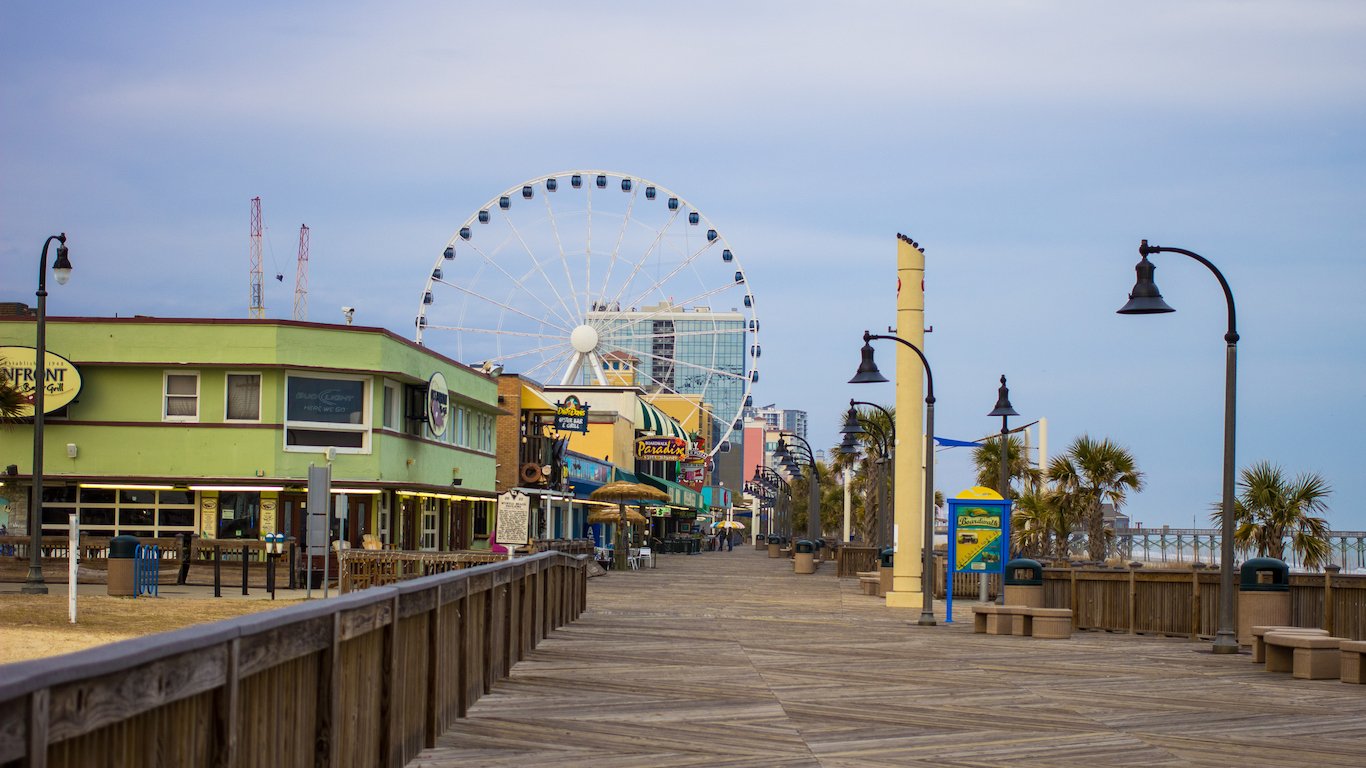
19. ZIP 29572 (Myrtle Beach, South Carolina)
> Vacant homes: 2,441 (17.6%)
> 5 yr. population change: 0.2%
> Population: 8,923
> Median home value: $264,000
Likely due in large part to its popularity as a tourist destination, 17.6% of homes in Myrtle Beach’s 29572 ZIP code are unoccupied. This specific part of the city is sandwiched between the Barefoot Resort and Grand Dunes golf courses on one side, and the Atlantic Ocean on the other. Very few unoccupied homes in the Myrtle Beach’s 29572 ZIP code are abandoned, as 96% of vacant homes in the area are investment properties.
Like other popular vacation destinations on this list, parts of Myrtle Beach, like the 29572 ZIP code likely only have near nation-leading vacancy rates during the off season.
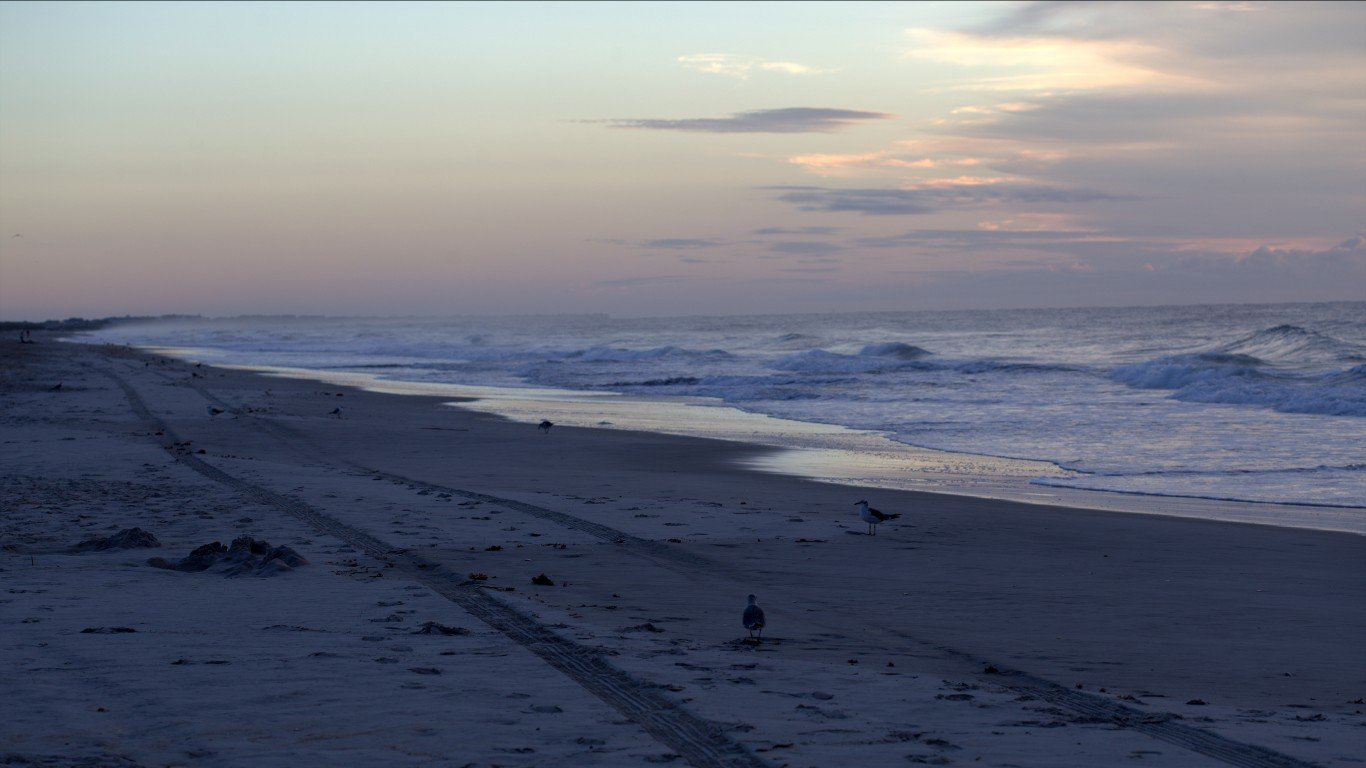
18. ZIP 28480 (Wrightsville Beach, North Carolina)
> Vacant homes: 465 (18.0%)
> 5 yr. population change: 1.1%
> Population: 2,546
> Median home value: $742,100
Many ZIP codes with high vacancy rates are characterized by financial hardship and depressed real estate values. The 28480 ZIP code, which covers the North Carolina town of Wrightsville Beach and some of the surrounding area along the Atlantic Coast, is not one of them. The typical area home is worth nearly three-quarters of a million dollars — more than four times the national median home value — and the typical area household income is $77,232 a year.
The town’s beachfront makes it a popular tourist destination, and visitors have plenty of rental homes and condos to choose from. Vacancy rates likely fluctuate considerably in Wrightsville Beach throughout the year, peaking in the off season.
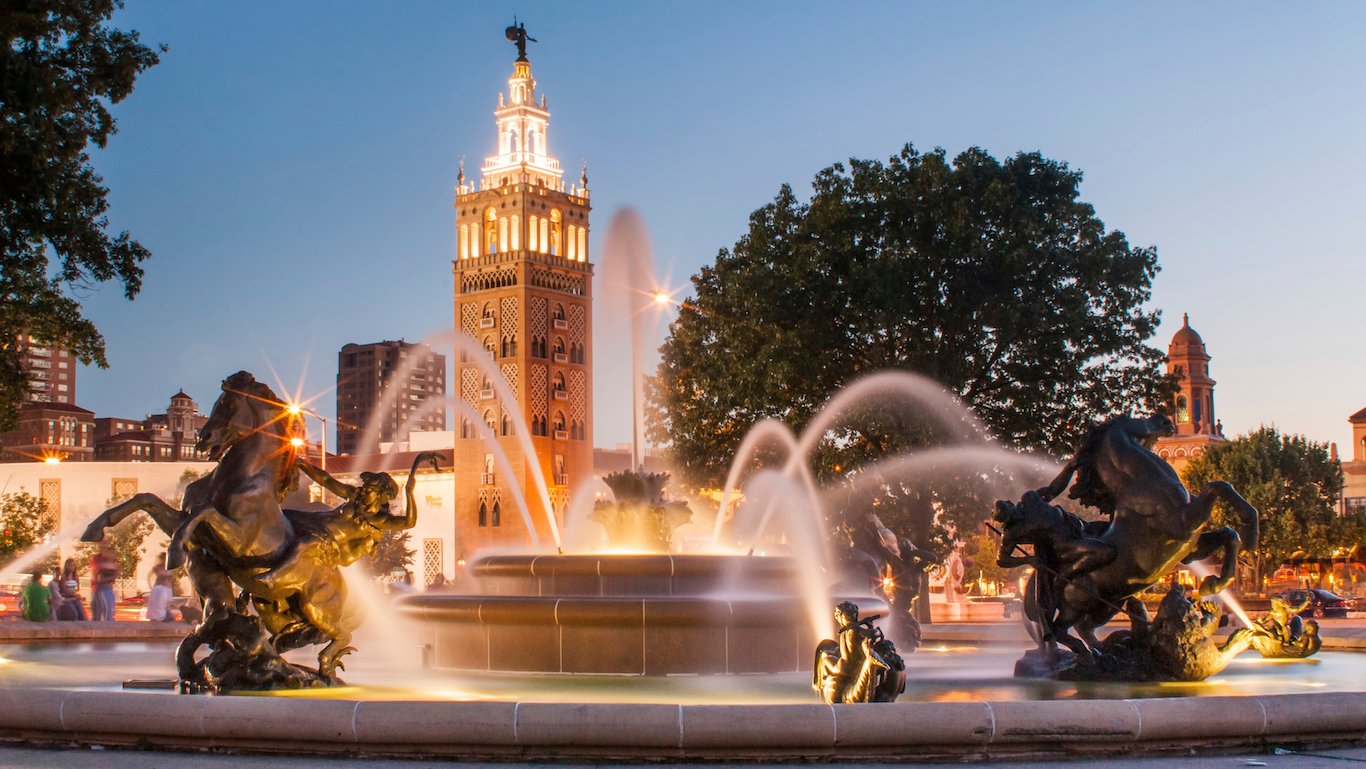
17. ZIP 64128 (Kansas City, Missouri)
> Vacant homes: 888 (18.3%)
> 5 yr. population change: -0.9%
> Population: 12,027
> Median home value: $41,900
Of the 4,856 single family homes and condos in this section of Kansas City, 888 are unoccupied — up from 877 last year. The 64128 ZIP code covers the Knoches Park, Oak Park Northwest, Palestine East, and Sante Fe neighborhoods, as well as Ingleside — one of the most dangerous neighborhoods in the city. Abandoned and vacant properties can be both a product of and breeding ground for crime.
Like many inner-city areas with high vacancy rates, the 64128 ZIP code in Kansas City has depressed property values and low incomes. More than one in three area residents live below the poverty line, and over half of all area homes are worth less than $42,000.
[in-text-ad-2]

16. ZIP 45214 (Cincinnati, Ohio)
> Vacant homes: 213 (18.3%)
> 5 yr. population change: -6.8%
> Population: 8,557
> Median home value: $57,600
The 45214 ZIP code extends from just west of Cincinnati’s Washington Park up through the West End neighborhood, over Mill Creek and into the Fairmount neighborhood. The area is one of the poorest in the country. Over half of all residents live in poverty, and the typical home is worth just $57,600 — less than a third of the national median home value. The widespread financial distress may be driving people out. In the last five years, the area’s population declined by 6.8%, and 18.4% of area homes are unoccupied.
Currently, an initiative is underway to convert abandoned and deteriorating homes in the greater Cincinnati area into affordable housing for the city’s lowest income residents. The Urban Land Institute of Cincinnati and Local Initiatives Support Corporation of Greater Cincinnati are leading the effort.

15. ZIP 48206 (Detroit, Michigan)
> Vacant homes: 1,051 (18.4%)
> 5 yr. population change: -21.7%
> Population: 18,049
> Median home value: $43,200
The 48206 ZIP code is one of two in Detroit to have some of the highest vacancy rates in the nation. Of the 5,715 homes in the neighborhood, 1,051 are unoccupied — an 18.4% vacancy rate. The area is contained almost entirely by I-94 and I-96 on the south and west and route 10 and route 8 on the east and north.
The area’s high vacancy rate is likely due in large part to a shrinking population and a depressed economy. In the last five years, the ZIP code’s population fell by 21.7%. Additionally, over half of all area households earn less than $22,500 a year, and 43.8% of households rely on SNAP benefits, formerly known as Food Stamps.
[in-text-ad]
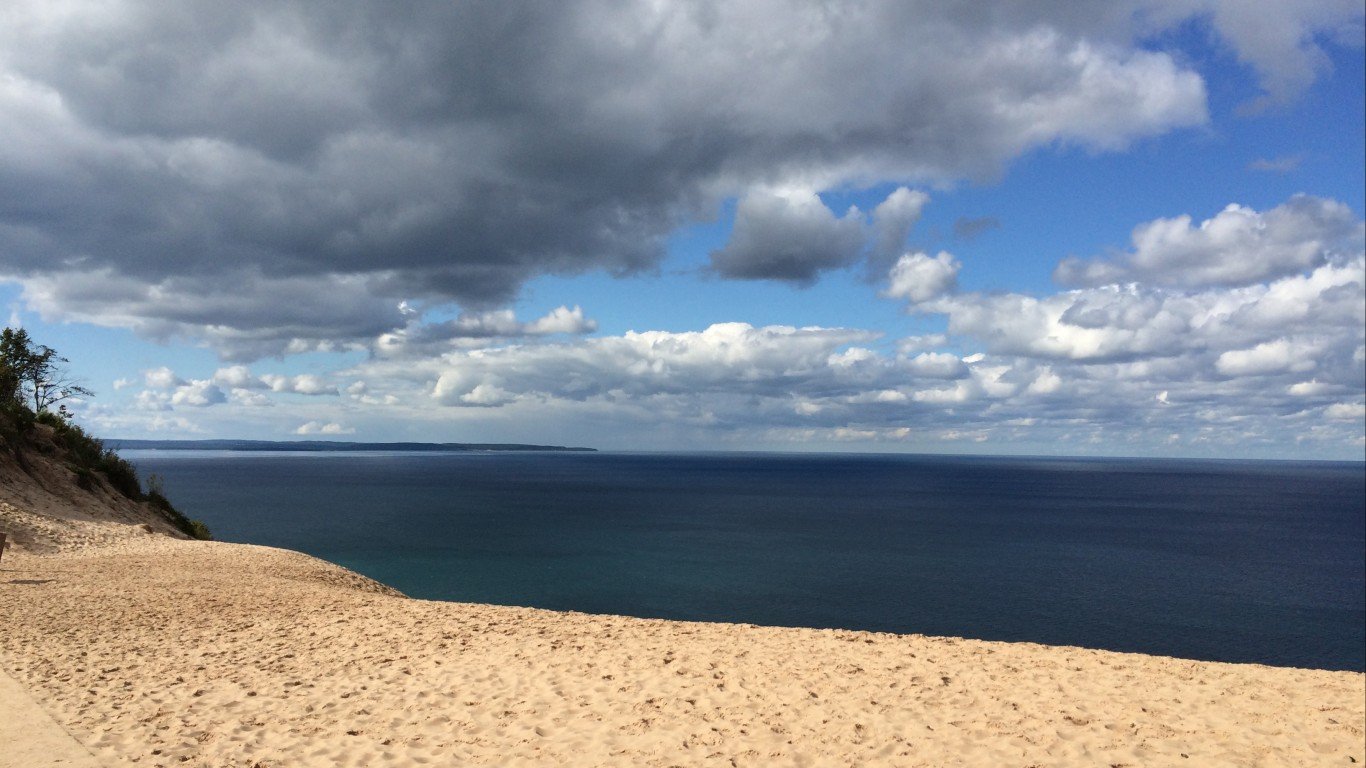
14. ZIP 49253 (Manitou Beach, Michigan)
> Vacant homes: 481 (19.2%)
> 5 yr. population change: -5.8%
> Population: 2,962
> Median home value: $167,100
Though it is one of five ZIP codes in Michigan to rank among the nation’s ghost towns, 49253 has little in common with the other Michigan neighborhoods on this list. Unlike the parts of Detroit and Flint with high vacancy rates where home values are depressed to a fraction of what the typical American home is worth, in the 49253 ZIP code, the typical home is worth $167,100, only slightly below the $184,700 national median. Also, unlike pockets of Detroit and Flint where more than one in three residents live in poverty, the poverty rate in the 49253 ZIP code is 8.8%, significantly lower than the national poverty rate of 15.1%.
Michigan’s 49253 ZIP code is not in a city and encompases Devils Lake and Round Lake and boasts outdoor recreation opportunities like boating and golfing. Marketed as an alternative to resort communities further north in the state, many of the area’s vacant homes — 19.2% of single family houses — are currently unoccupied because they are likely seasonal second homes.
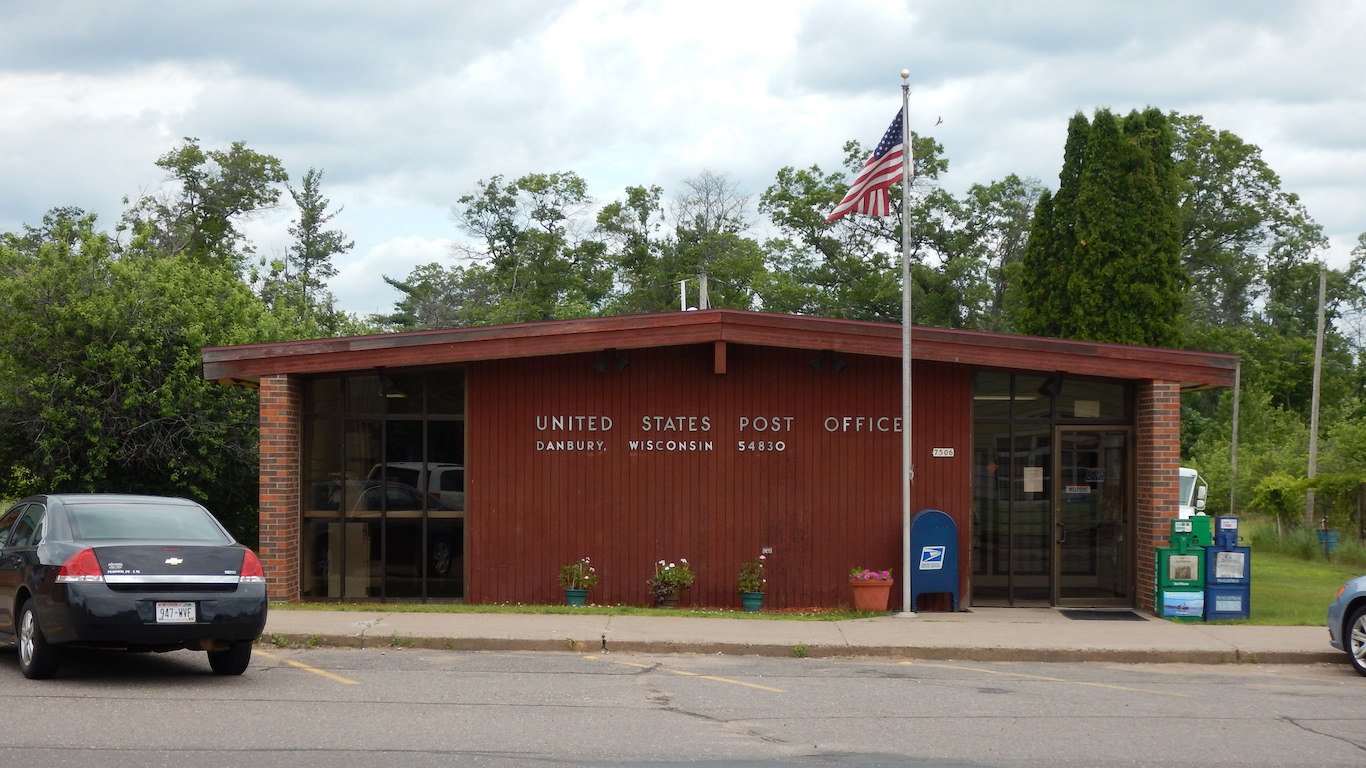
13. ZIP 54830 (Danbury, Wisconsin)
> Vacant homes: 870 (19.9%)
> 5 yr. population change: -1.5%
> Population: 2,932
> Median home value: $163,800
Nearly one in every five homes in the 54830 ZIP code in Wisconsin are unoccupied. The ZIP code is located in Northern Wisconsin along the Minnesota border, with the town of Danbury in the south and Dairyland in the north.
The southern half of the ZIP code is peppered with lakes, and many unoccupied homes are likely lake homes used only on a seasonal basis. Currently, 870 homes in the area are unoccupied. Population decline may also partially explain the area’s high vacancy rate. In the last five years, the number of people living in the area fell 1.5%.
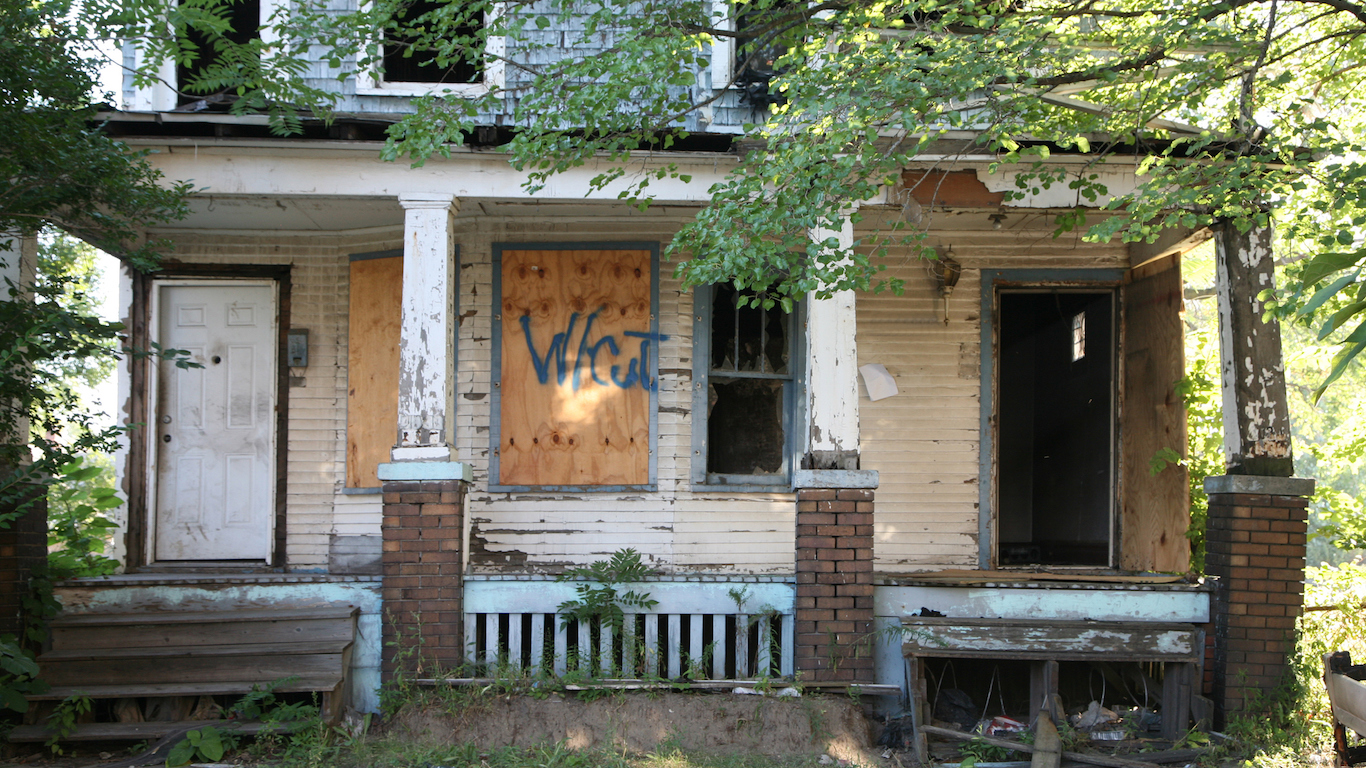
12. ZIP 48504 (Flint, Michigan)
> Vacant homes: 2,339 (20.5%)
> 5 yr. population change: -10.4%
> Population: 28,303
> Median home value: $35,200
Flint’s 48504 ZIP code has one of the highest vacancy rates in both Michigan and the United States. A Rust Belt city, Flint’s decline has paralleled that of the American auto industry as its population was nearly cut in half over the 40 years from 1970 to 2010. In the last five years alone, the city’s 48504 ZIP code, which comprises the northwestern section of the city and beyond, has lost 10.4% of its residents. Partially as a result, 20.5% of all area homes are currently unoccupied.
Some recent departures from Flint are attributable to the public health crisis caused by lead contamination in the city’s water supply. Since the Environmental Protection Agency detected dangerous lead levels in the city’s water supply in early 2015, many homeowners have wanted to leave the city but not all have been lucky enough to find a buyer for their homes.
[in-text-ad-2]
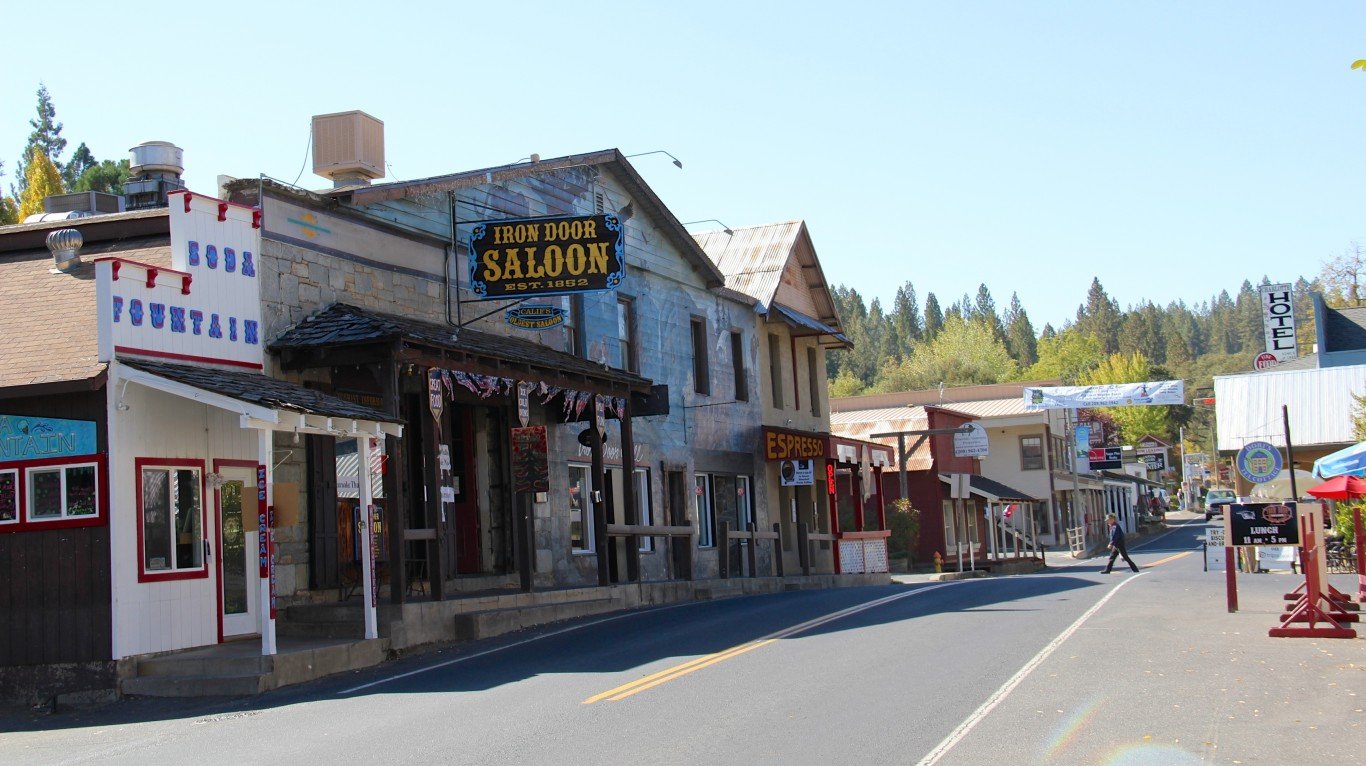
11. ZIP 95321 (Groveland, California)
> Vacant homes: 635 (20.8%)
> 5 yr. population change: -4.7%
> Population: 3,263
> Median home value: $261,100
The ZIP code enconpasses Groveland, California, and extends west into parts of Yosemite National Park and the Stanislaus National Forest.
Due to its close proximity to one of the most famous national parks in the country, the 95321 ZIP code is a popular tourist destination with plenty of home rentals and bed and breakfast options. The large amount of vacation homes and rental properties partially explains the high vacancy rate in the area. Currently, an estimated 635 area homes out of 3,059 are unoccupied. That number likey fluctuates throughout the year, declining in peak tourist season.

10. ZIP 33786 (Belleair Beach, Florida)
> Vacant homes: 265 (21.2%)
> 5 yr. population change: 2.8%
> Population: 1,671
> Median home value: $569,300
The 33786 ZIP code encompases the Belleair Beach community on Florida’s Gulf coast directly west of Tampa. The area’s 21.2% vacancy rate is due largely to vacation homes and rental properties. In contrast to inner city ZIP codes with high vacancy rates, home values are high in Belleair Beach. Over half of all area homes are worth over half a million dollars, and nearly 90% of empty homes in the area are investment properties, either open to vacationers, long-term renters, or waiting for a new buyer. Vacancy rates in Belleair Beach are likely far lower from January through March, Florida’s peak tourist months.
[in-text-ad]
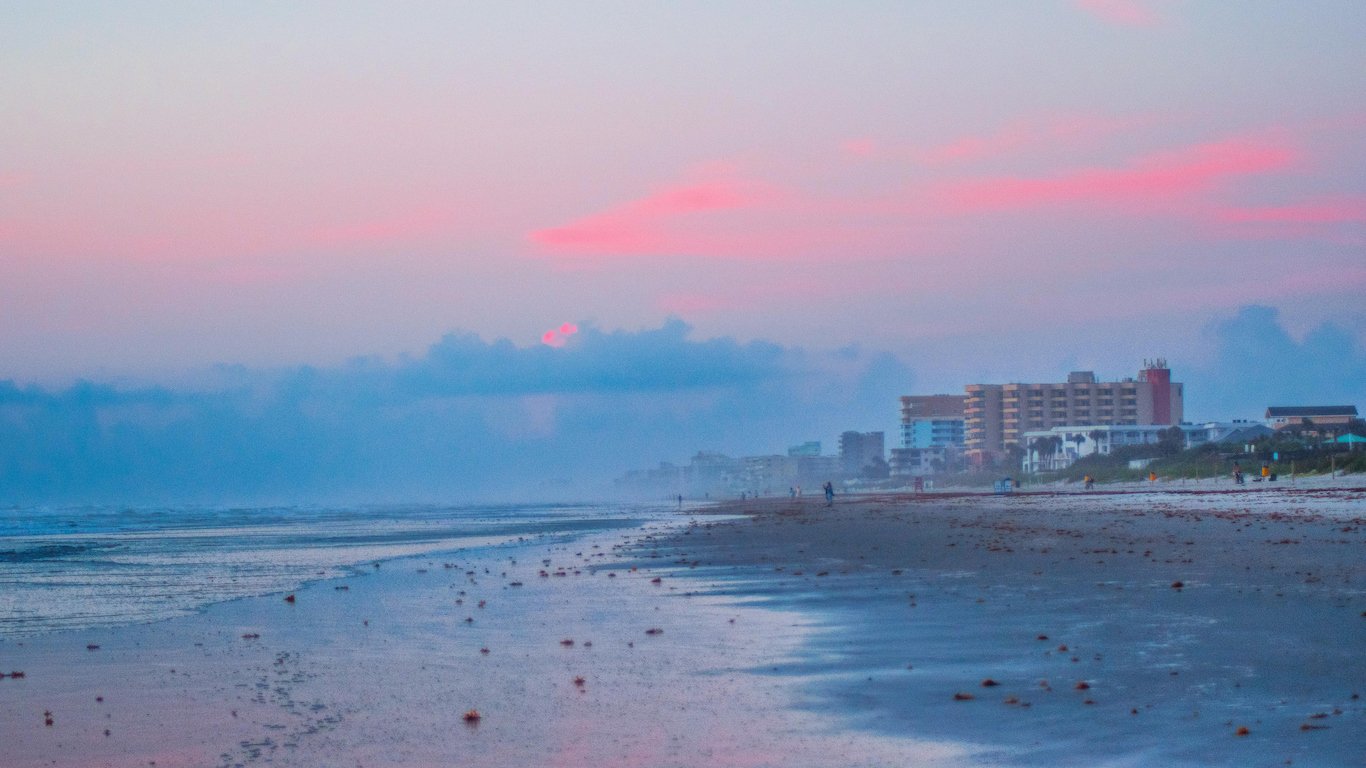
9. ZIP 33785 (Indian Rocks Beach, Florida)
> Vacant homes: 1,106 (21.6%)
> 5 yr. population change: -0.3%
> Population: 5,711
> Median home value: $376,000
Just like its neighboring ZIP code to the north in Belleair Beach, the 33785 ZIP code around Indian Rocks Beach and neighboring Indian Shores has a high vacancy rate. More than one in every five area homes are unoccupied. Also like its neighbor to the north, Indian Rocks Beach is located along Florida’s Gulf Coast in the Tampa metro area, and its high vacancy rate is largely attributable to the many vacation homes and rental properties that go through periodic vacancies.
Unlike many economically suffering inner city neighborhoods on this list, vacancy rates likely fluctuate throughout the year in Indian Rocks Beach, falling considerably in peak tourist months.
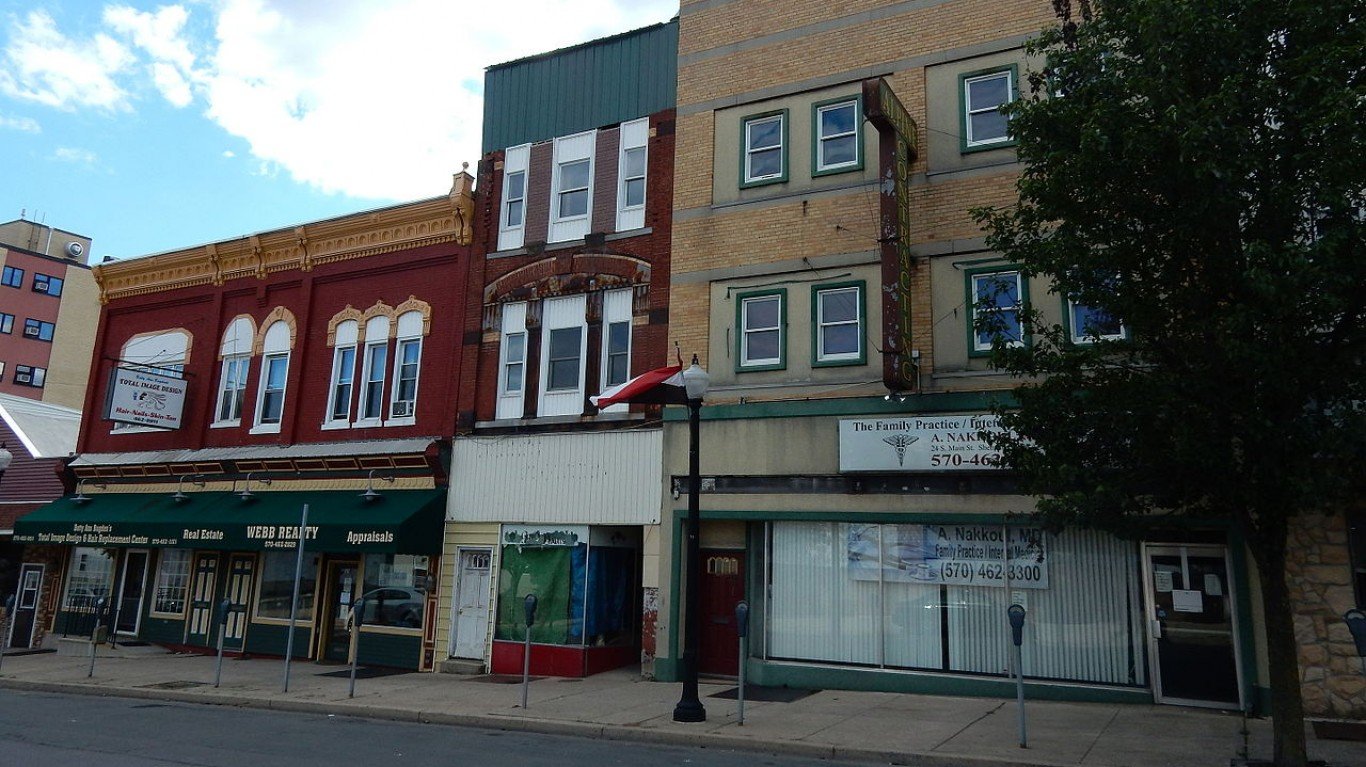
8. ZIP 17976 (Shenandoah, Pennsylvania)
> Vacant homes: 701 (22.9%)
> 5 yr. population change: -0.9%
> Population: 6,803
> Median home value: $36,900
Pennsylvania’s 17976 ZIP code comprises the borough of Shenandoah, about 150 miles west of New York City. A poor, economically depressed area, more than one in every three Shenandoah residents live in poverty, and over half of all area homes are worth less than $37,000. One of the area’s over 700 vacant homes is in foreclosure.
A coal mining town in the early 1900s, Shenandoah has long been in decline. When area mines began closing in the middle of last century, the few available jobs were largely in garment manufacturing. The borough’s population peaked at nearly 26,000 in 1910 and stood at just 5,000 a century years later. Though town officials claim people are moving back to the region, the 17976 ZIP code’s population shrank by 0.9% in the last five years, according to the U.S. Census Bureau.
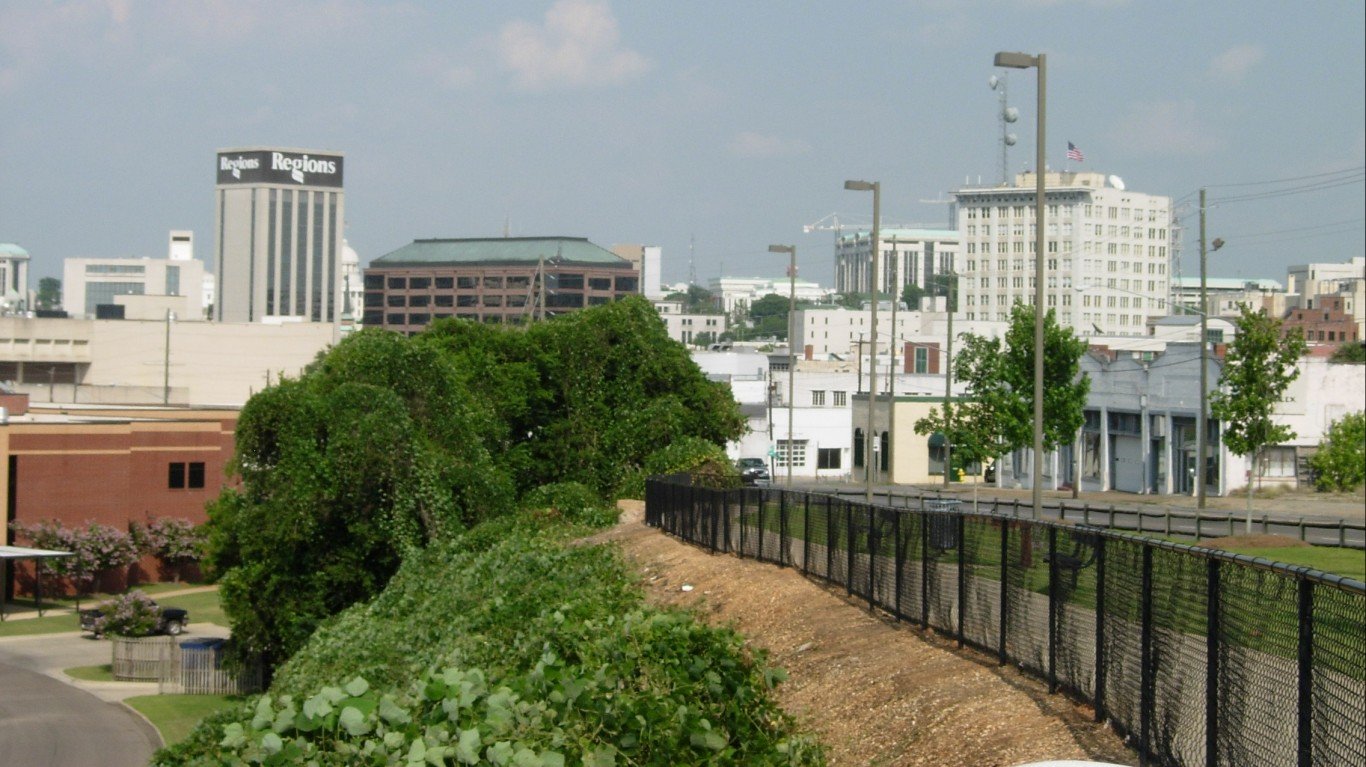
7. ZIP 36104 (Montgomery, Alabama)
> Vacant homes: 523 (23.4%)
> 5 yr. population change: -22.7%
> Population: 8,056
> Median home value: $73,700
Northern Montgomery, Alabama, along Gun Island Chute, falls largely within the 36104 ZIP code. Montgomery, the state capital, is poorer than most places. Across the broader metro area, 18.7% of residents live below the poverty line, compared to 15.1% of Americans. Like every other inner city ZIP code on this list, the 36104 area is one of the poorest parts of town, with 45.3% of residents living in poverty. Such poor economic conditions have likely driven many out of the area and reduced property values. In the last five years, the neighborhood’s population shrank by 22.7%. Additionally, the typical area home is worth just $73,700, less than half the median home value nationwide of $184,700.
Population decline and widespread poverty are hallmarks of urban areas that have been hollowed out. In Montgomery’s 36104 ZIP code, 23.4% of households are vacant.
[in-text-ad-2]
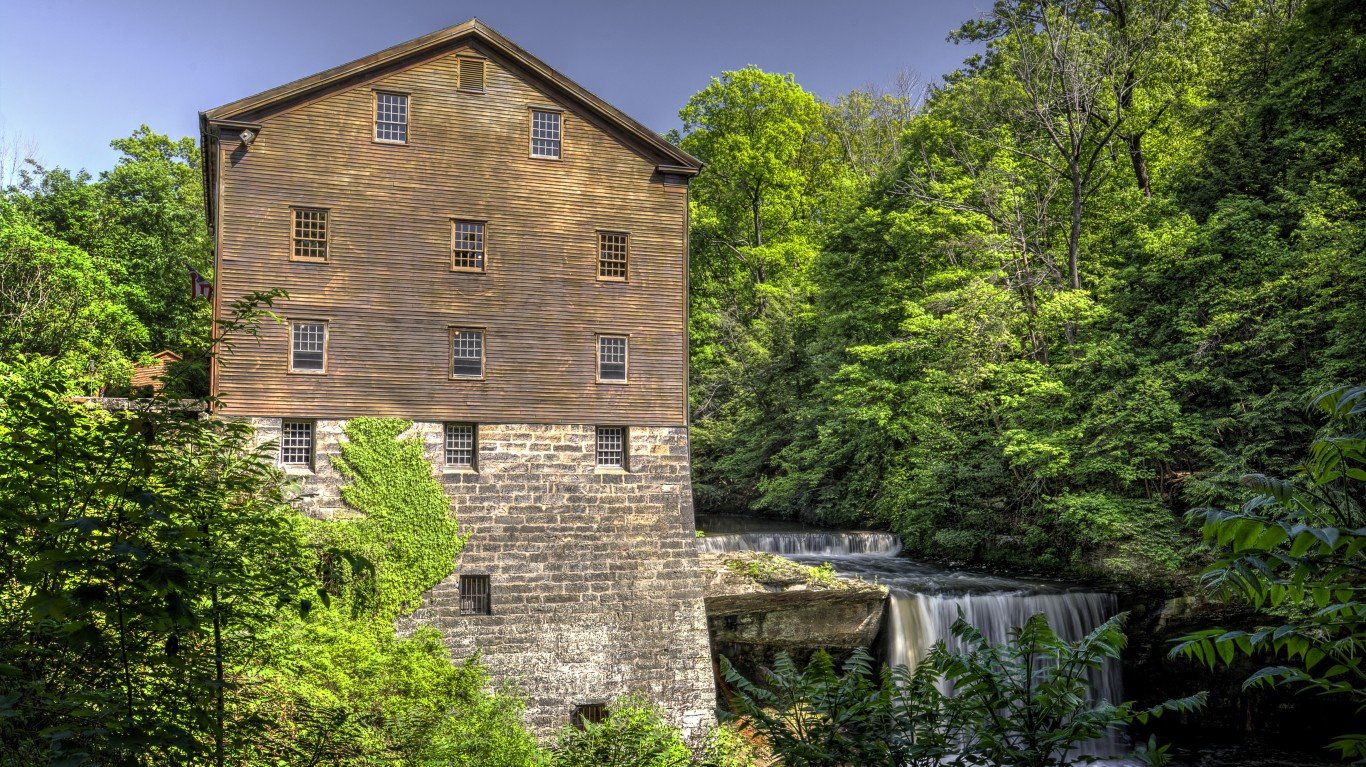
6. ZIP 44507 (Youngstown, Ohio)
> Vacant homes: 483 (23.7%)
> 5 yr. population change: -15.8%
> Population: 5,046
> Median home value: $20,000
Along with Cincinnati and Dayton, Youngstown is one of three Ohio cities with areas that have among the highest vacancy rates in the country. None, however, has a higher vacancy rate than the 44507 ZIP code in south-central Youngstown. Nearly a quarter of the 2,036 area homes are unoccupied. Of the area’s 483 vacant homes, a far lower than average 65.4% are considered investment properties, meaning they are owned by someone either intending to rent or sell. Many of the remaining vacant homes have likely been abandoned.
One of the poorest neighborhoods in the country, over half of residents in this section of Youngstown live below the poverty line, and the typical area home is worth just $20,000.
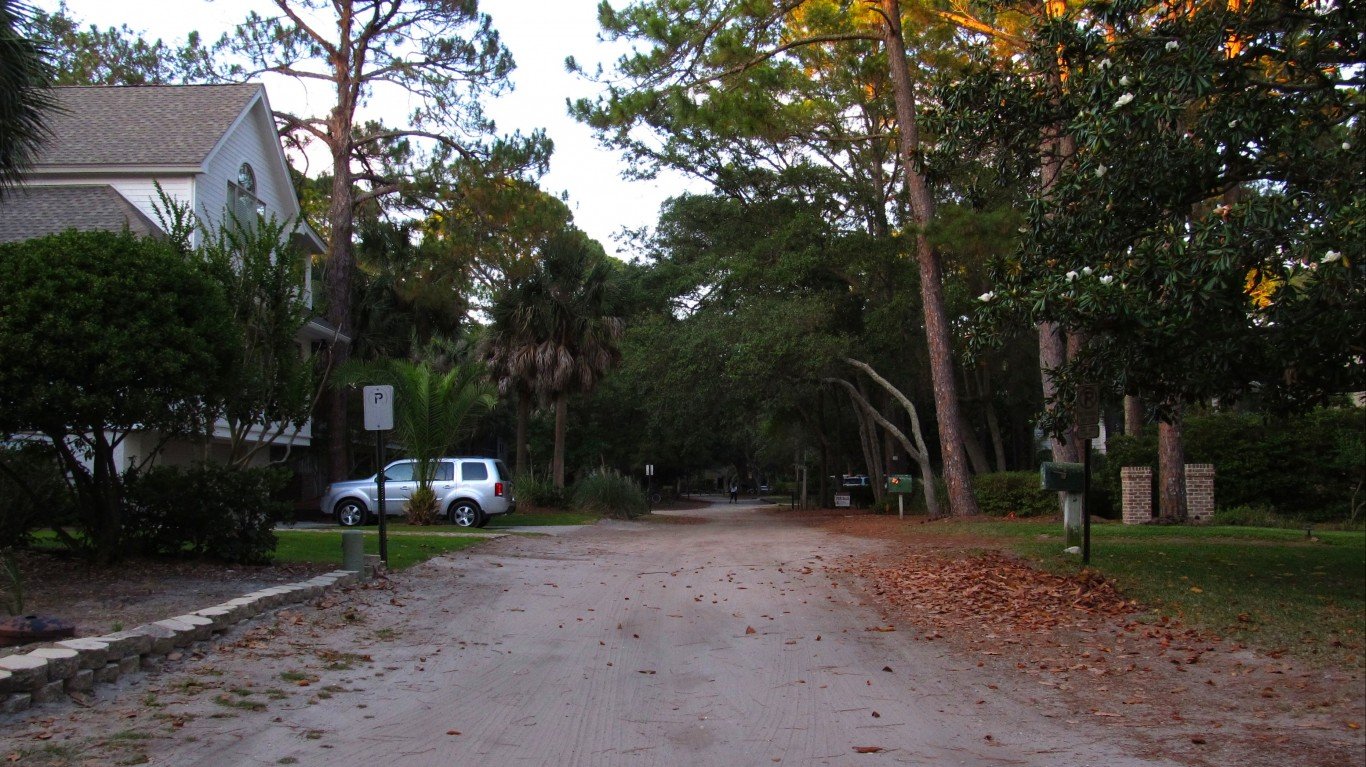
5. ZIP 29928 (Hilton Head Island, South Carolina)
> Vacant homes: 5,227 (26.4%)
> 5 yr. population change: 11.8%
> Population: 17,103
> Median home value: $542,400
ZIP code 29928 makes up the eastern shore and southern tip of Hilton Head Island in South Carolina. It is the only vacation and resort community to rank among the ZIP codes where more than one in every four homes are unoccupied. Like other beach communities on this list, the high amount of rental properties and vacation homes likely explain the high vacancy rate in the 29928 ZIP code.
In stark contrast to inner-city communities with high vacancy rates, Hilton Head Island boasts 12 miles of beaches, two dozen golf courses, and hundreds of tennis courts and restaurants. Additionally, the local population has grown by 11.8% in the last five years, and more than half of all area homes are worth over half a million dollars.
[in-text-ad]
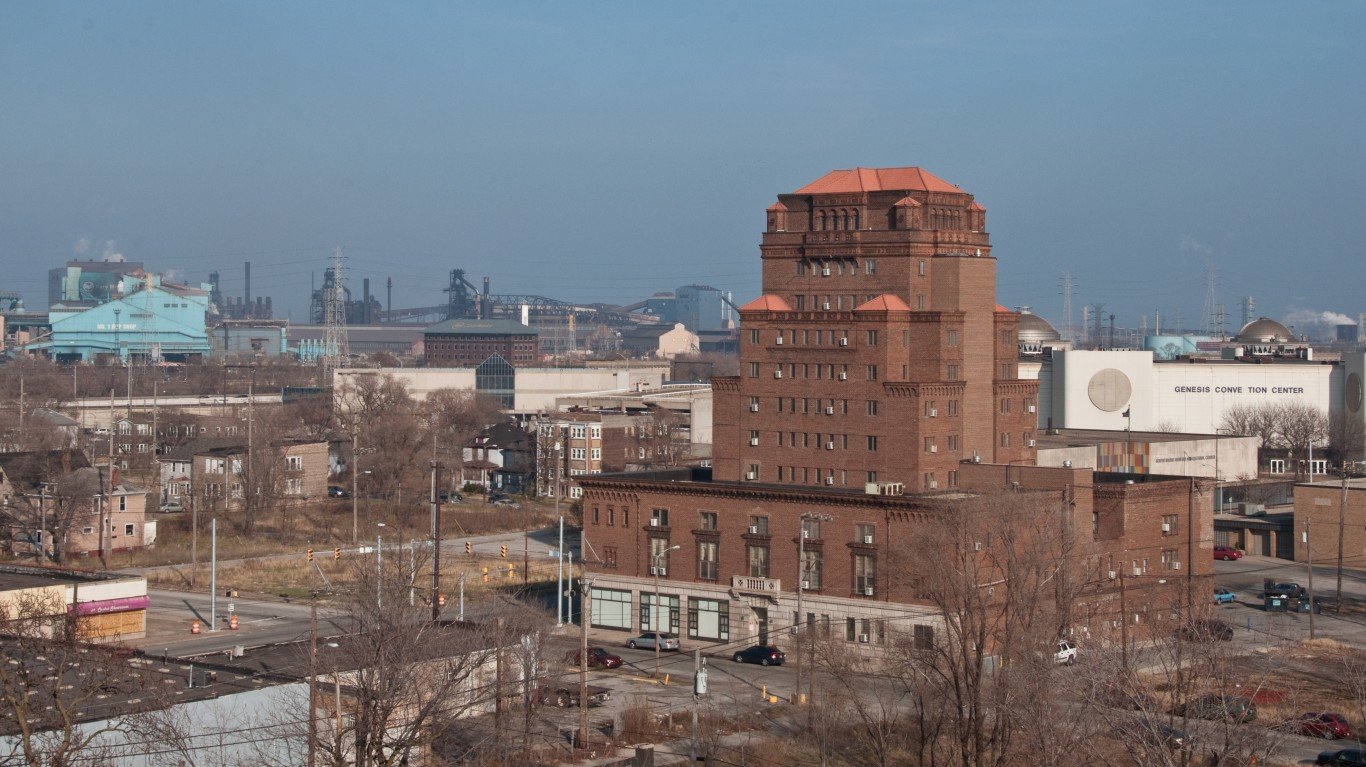
4. ZIP 46407 (Gary, Indiana)
> Location: Central Gary,
> Vacant homes: 1,160 (28.6%)
> 5 yr. population change: -15.5%
> Population: 11,728
> Median home value: $51,000
The 46406 ZIP code, which is bisected by Route 53 and has I-94 along southern border, is one of five sections of Gary, Indiana, with a vacancy rate high enough to rank on this list. Crippled by high poverty and a high incidence of violent crimes, the 46407 ZIP code’s population fell by 15.5% in the last five years. The population decline partially explains the area’s high vacancy rate as currently, 28.6% of area homes are unoccupied. A far larger than typical share of homes have simply been abandoned as just 65% of vacant homes are considered investment properties, meaning they are owned by someone either intending or attempting to rent or sell. Nationwide, 75% of unoccupied homes are considered investment properties.
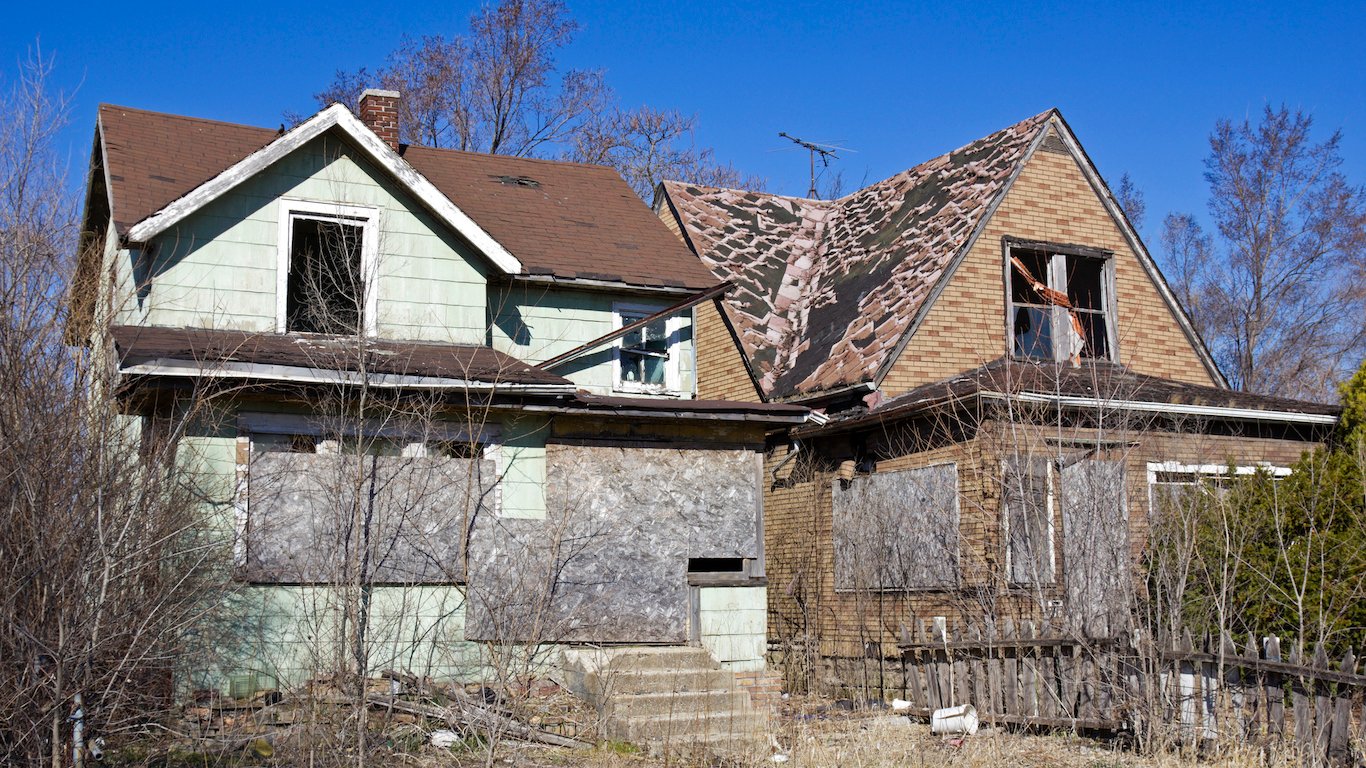
3. ZIP 46409 (Gary, Indiana)
> Vacant homes: 1,081 (28.9%)
> 5 yr. population change: -17.0%
> Population: 8,094
> Median home value: $57,700
Over 1,000 homes in the 46409 ZIP code, bordered by Route 53, I-94, and I-65 in southern Gary, Indiana, are unoccupied. A poor neighborhood, more than one in three residents live in poverty, and three of the 22 area homes that are currently in the early stages of foreclosure are abandoned.
Like other high-vacancy inner-city ZIP codes, southern Gary is characterized by a depressed real estate market. Due in part to steep population decline — 17.0% in the last five years — the area’s median home value of $57,700 is a fraction of the $184,700 the typical American home is worth.

2. ZIP 48505 (Flint, Michigan)
> Vacant homes: 3,220 (31.2%)
> 5 yr. population change: -17.8%
> Population: 21,231
> Median home value: $24,900
Flint’s 48505 ZIP code is in the northern part of the city and is bisected by I-475. The area’s 31.2% home vacancy rate is partially a byproduct of Flint’s long economic downward spiral, spurred by the decline of American auto manufacturing. Flint’s population peaked at nearly 200,000 in the 1960s, but the city is now home to less than 100,000 residents. In recent years, a discovery of lead in the city’s water supply has driven residents out of the area and reduced demand for homes and dragged down real estate values. In the last five years, the population of the 48505 ZIP code declined by 17.8%. The typical area home is worth just $24,900, just 13% of the median home value nationwide of $184,700.
[in-text-ad-2]
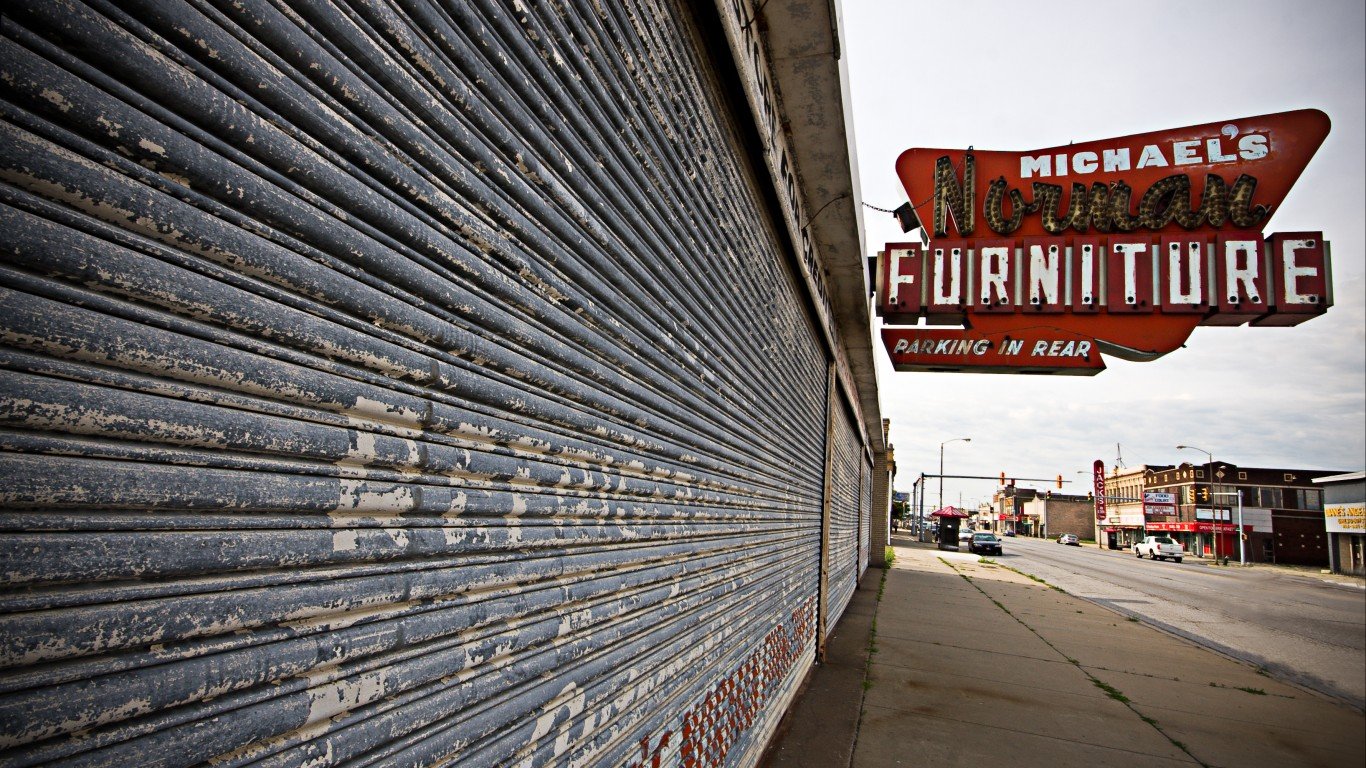
1. ZIP 46402 (Gary, Indiana)
> Vacant homes: 573 (31.4%)
> 5 yr. population change: -7.7%
> Population: 6,284
> Median home value: $58,600
Of the 1,824 single family homes in the 46402 ZIP code, 573, or 31.4% are abandoned, the highest vacancy rate of any ZIP code in the country. The 46402 ZIP code in Gary extends from Central Ave to the Lake Michigan shore and includes the City Methodist Church, an allegory for the decline of the city itself. The church, which was constructed in 1926 for the equivalent of about $11 million in today’s dollars and with a 3,000 person capacity is now an abandoned ruin, apocalyptic in appearance.
Currently, just 67.5% of empty homes in the ZIP code are owned by investors, well below the comparable 74.9% share nationwide. Additionally, of the nine homes in the early stages of foreclosure in the area, three are abandoned.
Detailed Findings
The ZIP codes on this list generally fall into one of two broad categories. The first category is the poor urban neighborhood. These areas are generally concentrated in Rust Belt cities characterized by poor economic conditions and often high crime rates. The ZIP codes on this list that fall into that category include two in Baltimore, two in Detroit, two in Flint, Michigan, and five in Gary, Indiana.
Poverty rates in those neighborhoods are all more than double the 15.1% national rate and range from 31.7% to 49.7%. Property values also are depressed. Nearly across the board, median home values in these areas are worth less than half the nationwide median value of $184,700.
In these areas, long-term industrial declines have wiped out job opportunities and given way to a shrinking population and reduced demand for housing. These neighborhoods often are also in relatively dangerous cities, and high vacancy rates can be both product of and breeding ground for crime.
The second category of neighborhoods on this list are vacation areas. Unlike the inner-city ZIP codes, the high vacancy rates in these areas are likely seasonal. These neighborhoods are often coastal and include parts of the Carolinas along the Atlantic and Florida communities along the Gulf coast. There are also some rural Midwestern ZIP codes that likely fall into this category.
Home values in these areas are generally high, with the typical home often worth over half a million dollars. These areas are popular tourist destinations, and as such have an uncommonly high share of vacation homes and rental properties. Vacancy rates likely drop precipitously during peak tourist season in these areas.
Methodology
To identify America’s 30 ghost towns, 24/7 Wall St. reviewed the share of single family homes and condos that are unoccupied in 15,957 ZIP codes. Occupancy status was determined by ATTOM Data Solutions using tax assessor data for the end of the third quarter in 2018. Median household income, median home value, poverty rates, and SNAP recipiency at the ZIP code level are all five-year estimates from the 2016 U.S. Census Bureau’s American Community Survey and are for the most recent year available. Five-year population changes from 2011 to 2016 are also from the ACS. Violent crime rates and homicide rates at the metro area level are from the FBI’s 2017 Uniform Crime Report.
Essential Tips for Investing: Sponsored
A financial advisor can help you understand the advantages and disadvantages of investment properties. Finding a qualified financial advisor doesn’t have to be hard. SmartAsset’s free tool matches you with up to three financial advisors who serve your area, and you can interview your advisor matches at no cost to decide which one is right for you. If you’re ready to find an advisor who can help you achieve your financial goals, get started now.
Investing in real estate can diversify your portfolio. But expanding your horizons may add additional costs. If you’re an investor looking to minimize expenses, consider checking out online brokerages. They often offer low investment fees, helping you maximize your profit.
Thank you for reading! Have some feedback for us?
Contact the 24/7 Wall St. editorial team.
 24/7 Wall St.
24/7 Wall St. 24/7 Wall St.
24/7 Wall St.
